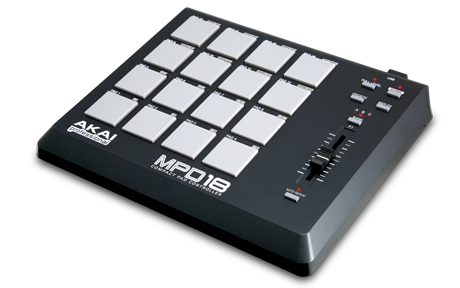In which I review the Akai MPD18 Pad Controller
I’m really into making music on my computer, using software like Propellerhead Reason and Apple Logic, but I’ve never been great at making drum beats. I have a MIDI keyboard, but it’s not great for tapping out rhythms, and dragging the notes onto the sequencer grid is not really spontaneous or fun - so, about a month ago, I bought an Akai MPD18.

There have been MIDI-over-USB drum pads on the market for years now, but they’ve either been too pricey for my liking (the M-Audio Trigger Finger is about $150) or too tiny (the $60 Korg NanoPad looks pretty flimsy, and has only 10 pads). I was drawn to the MPD18 by a number of factors: it has 16 pads, it costs less than $100, and Akai have a good reputation when it comes to drum pad products. I got a refurbished one for $87, and I got free shipping, which seemed like a great deal.
First Impressions
One of the first things I noticed about the MPD18 is that its size is perfect for me. It fits comfortably in my lap, which is great, as I have very little desk space. Its front panel is interface is quite basic: it has a few buttons, and a nice chunky “Q-Link” slider. I really like the simplicity of the controls - my MIDI keyboard has dozens of buttons whose purpose I don’t understand, so the Akai’s sleek interface is refreshing.
It took a little experimentation to get the slider to work in Reason - there’s no preset controller template included, so I had to set it up as a generic MIDI instrument. Although the slider didn’t work straight away, the pads certainly did - I was tapping out beats in seconds. It even has aftertouch, which is a cool (if gimmicky) feature when I’m using it to control non-drum instruments.
Insensitivity
My one complaint with the MPD18 is that the pads are not very sensitive. Most of my taps will have a velocity of around 50 or 60, which is very quiet considering that the maximum MIDI velocity is 127 and that I’m not being gentle. There is a “Full Level” button you can toggle, which sends all notes with maximum velocity, but that defeats the purpose of a touch-sensitive controller. This appears to be a common complaint with Akai’s non-MPC pad instruments, due to a small but significant gap between the pad and the internal trigger. A friend of mine has the same issue with his MPK49’s pads - he referred me to some forum posts which advocate opening the case and placing a few layers of electrical tape over the triggers. This would be a really easy fix, but I’m reluctant to void the warranty on my new toy.
In summary
I’m very happy with my MPD18. It’s been a real boon to my amateur beat-making, and I think it’s the right price for its level of functionality. The pads’ insensitivity is a little annoying, but it’s not a dealbreaker. For the price, it’s pretty hard to beat.
(PS: If this review has helped you decide to buy an MPD18, and you’d like to help support this blog financially, then please buy your MPD18 from here if you’re in the US or here if you’re in the UK. Thank you very much!)